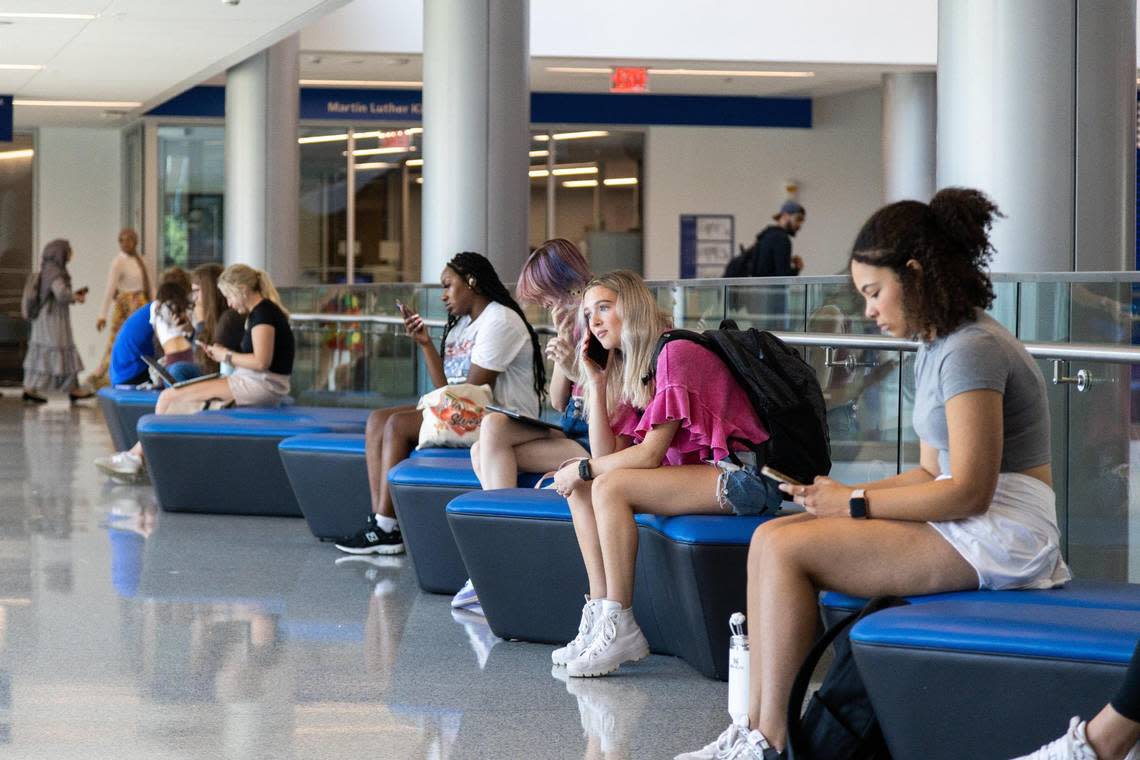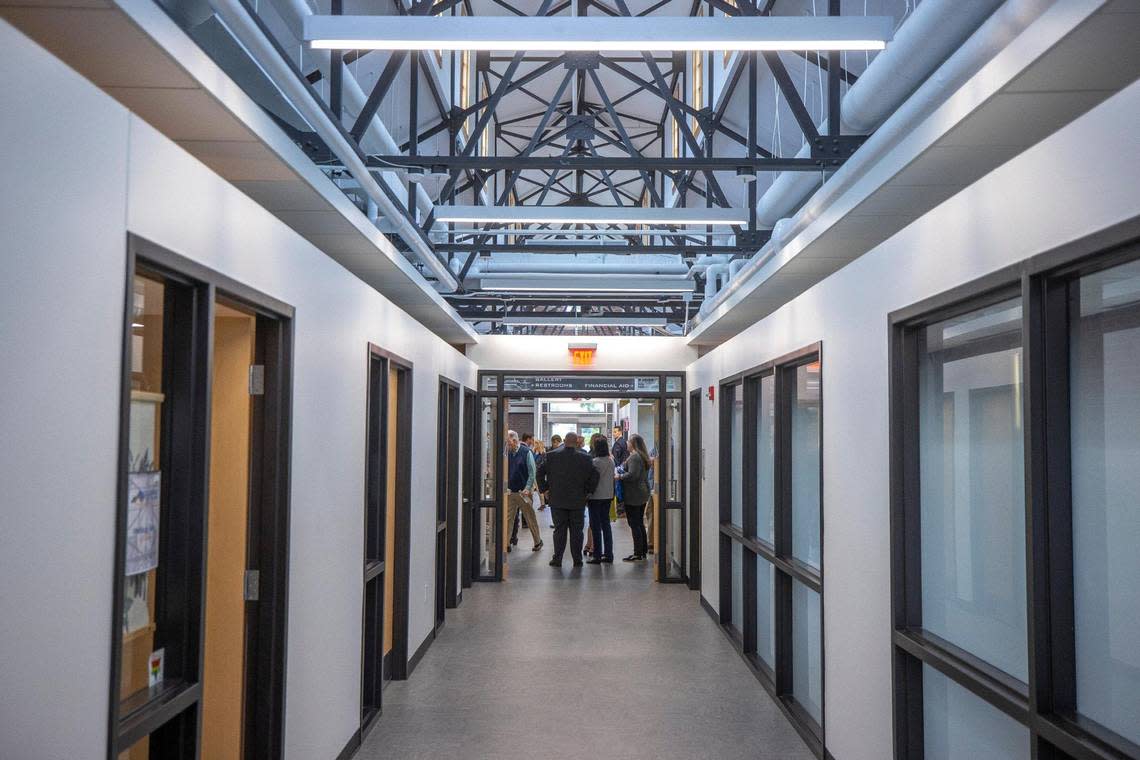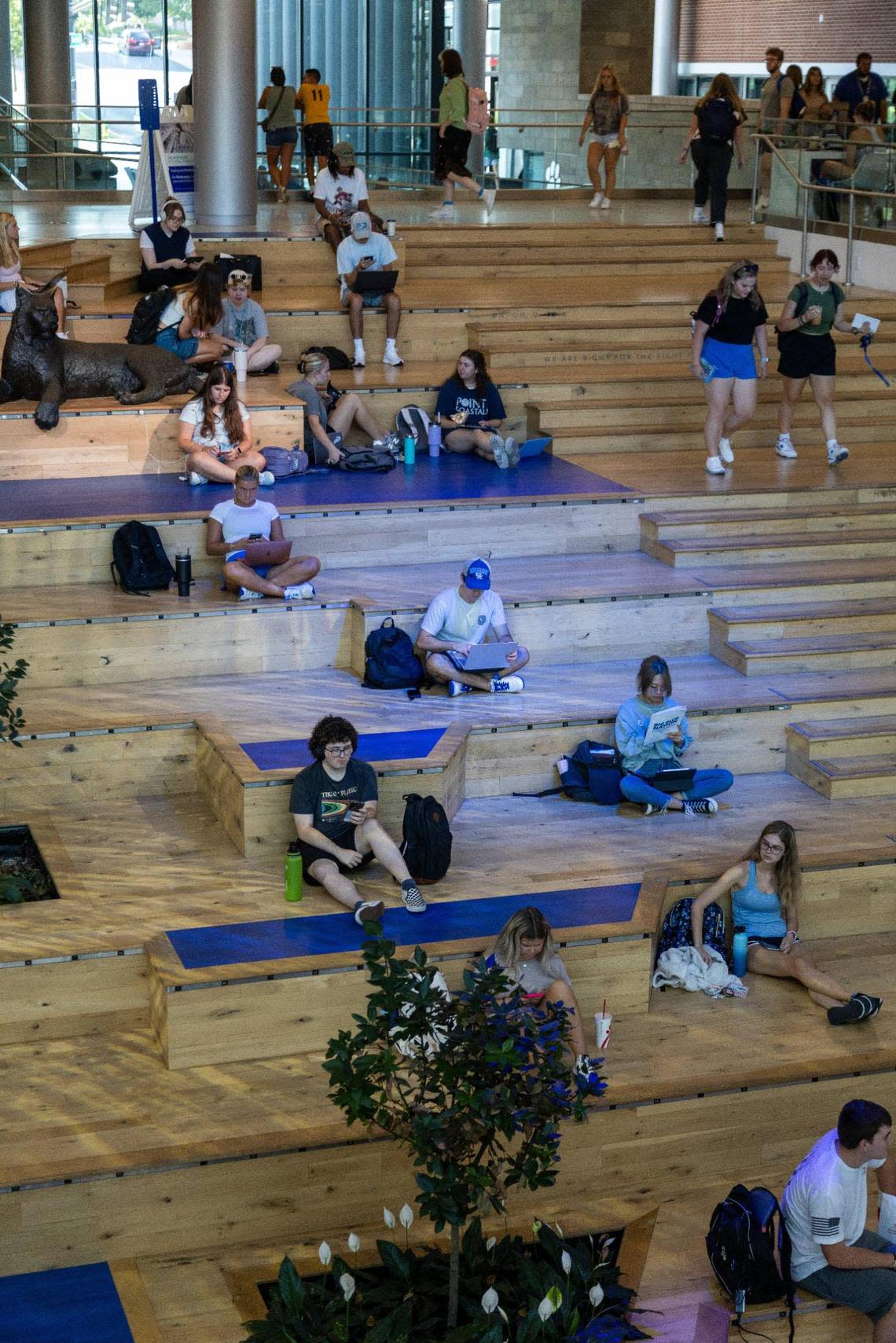Enrollment is shifting at KY universities. How will that change the college experience?
On the first day of classes at the University of Kentucky, Juanes Ramirez sat in the Gatton Student Center.
It was mid-morning at the start of a heat wave in Lexington, and temperatures were already climbing into the 80s. He sat with DeLainey Potts before their next classes.
Though it was Ramirez’s sophomore year, it was his first at UK. He transferred from Eastern Kentucky University after learning more about UK’s music programs, and for the opportunity to be in the marching band at a SEC school.
“There’s a big love for UK in my household, so it was exciting to be able to continue that family tradition we have,” Ramirez said. “And on top of that, I was always really interested in the musical programs here.”
Statewide, college enrollment has been declining over the last 10 years. Some institutions however, like the University of Kentucky, are seeing record enrollment growth. To sustain long-term enrollment growth, college are making changes to how they operate and learning more about what students need.
When Ramirez decided to come to UK, the school’s diversity also was important. Originally from Columbia, Ramirez said UK’s programs, like the Martin Luther King Center, stood out and immediately made him feel included. He saw an investment in its diverse student body, and felt that he would be welcomed. It made “a big campus feel small,” he said.

But nationally, the number of students enrolling in undergraduate programs is declining. From 2019 to 2022, undergraduate enrollment fell 8%, according to data from the National Student Clearinghouse.
Undergraduate enrollment has fared better at 4-year institutions than elsewhere. From 2019 to 2022, undergraduate enrollment at public four-year colleges saw a 3% decrease. At community colleges in the same time period, undergraduate enrollment fell 16%.
In Kentucky, college enrollment has dropped in the last decade from 261,613 students enrolled at colleges in the state in the 2012-2013 school year, to 250,828 students in the 2022-2023 school year — a 4% decrease, according to enrollment data from the Council on Postsecondary Education.
However, some institutions have managed to buck that trend in recent years. The University of Kentucky had gradual increases throughout the pandemic, and in the past two years has experienced record-setting enrollment. Last month, UK welcomed its largest-ever class of freshman students and predicted this fall will be its largest enrollment ever, surpassing 33,000 students, while some regional universities, like Western Kentucky University, have struggled to recover enrollment losses in recent years.
Bluegrass Community and Technical College enrollment has been slightly less predictable, with increases in some years and decreases in others. College officials said they are expecting growth this fall, anticipating large increases in the number of dual enrollment students.
University officials in Kentucky said the pandemic reshaped many of the norms at schools. Enrollment changed, and schools had to adjust to support their populations.
“COVID was a shifter for everyone,” said Kirsten Turner, UK’s vice president for student success. “We saw our enrollment not on that same upward trajectory. Not all-time highs, but still healthy enrollment, just not higher than each year.”
The fall 2022 semester brought a record number of first-year students, and a record overall enrollment. This fall, UK is anticipating more than 6,400 freshman students, and another record overall enrollment. (Enrollment data won’t be finalized until several weeks into the fall semester, after the date when students can drop classes or change their enrollment status.)
“UK has done a very good job of branding themselves as a holistic institution,” said Aaron Thompson, president of the Council on Postsecondary Education, which oversees the state’s universities and community and technical colleges. “UK has really created themselves as a modern day campus that serves students in a variety of ways.”
What does a growing enrollment mean for campus?
Housing was already tight at UK as the school awaited its largest-ever freshman class to arrive on campus. Last year, UK utilized temporary housing options as 6,000 freshmen enrolled.
In total, UK has more than 8,000 beds available for undergraduate students on campus, including dorms, specialty housing and Greek housing. It’s the most on-campus housing UK has offered at one time, Heath Price, associate vice president for partnerships at UK, previously told the Herald-Leader.
The housing shortage didn’t stop students from applying to live on campus, though. Freshman Kourtney Kloos said the campus tour and dorms were part of what convinced to her attend UK, along with the short drive to her hometown of Louisville.
“I applied to Tennessee, Auburn, Alabama, a bunch of SEC schools,” Kloos said. “And once I toured UK ... I just loved it. From the tour, everything’s so new. The dorms were a big selling point. Everyone I met was so nice.”
Around 86% of first-year students typically live on campus.
This fall, with 400 more freshmen students than enrolled last year, UK again turned to creative solutions for housing. Multi-purpose rooms were converted into living spaces, and UK launched a pilot program called TRI-IT, which converted two-bedroom, two-person suited into three-person suites.
UK anticipates future classes continuing to grow, meaning housing will continue to be in demand in the coming years.
While BCTC has looked to younger students, at UK, the number of graduate students enrolled has grown. In the 2012-13 school year, there were 7,127 graduate students enrolled.
That number has grown, especially in the last four years. While undergraduate enrollment had only slight increases during the pandemic, graduate enrollment grew from 7,166 students in 2019 to 8,812 students in 2022.
“Overall enrollment during the past few years in the pandemic did increase, but it was really driven by graduate students,” said Todd Brann, executive director of UK’s institutional research, analytics and decision support.
At BCTC, where students don’t live on campus and the population ranges from high school students to someone returning for a second degree, students began asking for more online options. Greg Feeny, acting president of BCTC, said they made decisions based around the motto, “One student at a time.” That often means slowing down or occasionally changing the norm to adjust to what could best help a student, he said.
This shift in approach could mean offering things like evening or weekend appointments, and communicating more often with high schools about dual enrollment offerings, credits and degree paths.
As dual enrollment and dual credit options are becoming more popular among students, there are now younger students on BCTC’s campus which means parts of the college experience are changing, too. The number of dual credit students — those who are taking courses for college credit while still enrolled in high school — has doubled in the past two years, said Emma Gibbs, director of dual credit at BCTC.
“It’s definitely been a welcome change,” said Gibbs. “It’s awesome to have so many people on campus.”

But with younger students — nearly 3,000 dual credit students are expected this fall — come adjustments for professors and administrators. Dual credit students are still in high school, and may not yet know how to operate on a college campus or in a college course. They have to learn how to complete college-level work, and oftentimes, become more independent.
A few courses are most popular for dual credit, including general education classes that students will take in college, like 100-level English, math and history courses, as well as health courses like nursing and medical terminology that students need as prerequisites for a health major. Students are also interested in certificate courses, like electrical and welding tracks, that allow them to immediately enter the workforce.
Along with dual credit options, schools within the Kentucky Community and Technical College System are often the most affordable option for students who want to transfer to a four-year college, Thompson said. It also helps students move into technical careers quickly, he said.
“You’re going to get a quality education, and then you move to a four-year institution after that,” Thompson said. “But we’ve also had a big increase in the need for advanced manufacturing and technical skills, and you can get a short-term credential that will help you move into a high-paying job fairly quickly.”
Changes in students
As institutions change their strategies and offerings, the student body has changed along with them. While previous students may have been more hesitant to speak up or ask for help and accommodations, BCTC and UK administrators said the current classes of students are more willing to advocate for themselves.
“Students know themselves more than they did five years ago,” Feeny said.
At BCTC, that meant providing more support for students, from things like laptops to the food bank.
Increases in the number of dual credit students mean more younger students in classes and on campuses, Gibbs said. Professors and administrators have had to work with students on skills like organization and preparation for college-level classes.
At UK, Turner said she’s seen more “self-advocacy” from current students.
“We’ll see students come in and say, ‘I don’t know if I need counseling, but I want to know where the counseling center is,’” Turner said.
Especially among younger students, Turner said they are more willing to speak up for themselves than in years past. Students want to know what support UK offers outside the classroom, and have taken advantage of them.
Jakob Combs, a junior from London, Kentucky, said he chose UK because of its diversity and location. The ability to live in a city that was different from the small town he grew up in was a huge factor when deciding on a college.

“I really just wanted a change in scenery, a change in the people that are around me, and really wanted to diversity my own life and become a more accepting and inclusive person,” Combs said.
He works as a resident assistant at UK, and said he views that as a way to help younger students find that diversity at the university.
“I try to teach other students that are incoming, that are maybe from small towns, about a bunch of different cultures and a bunch of different identities that we have on this campus,” Combs said. “I want everyone to more inclusive, and it’s just really nice knowing that I’m able to help with a little learning moment for people, and people are willing to learn too.”
Recruiting
UK has changed its recruiting strategy in recent years, Turner said. Instead of sending recruiters to cities, they now have dedicated recruiters who live in cities around the region, like Atlanta and Chicago. It’s something UK did prior to COVID, but recently expanded.
“We think that has been successful for us, because the UK person gets to know the city and the high school and the high school student in different ways,” Turner said.
BCTC, meanwhile, has poured resources into dual credit and certification programs, turning to local high schools.
Lafayette High School, Paul Lawrence Dunbar High School and Bryan Station High School send the most students to BCTC, but students come from outside Fayette County, too, including Jessamine and Woodford counties.
“It really is a team effort, and being aware of the common goal,” Gibbs said.
Potts, who sat with Ramirez on the first day at UK, she also appreciated the community aspect of UK, especially the professors she’d had.
“I’ve never met a teacher I didn’t like,” Potts said. “Everyone’s open and willing to help.”
In her time at UK, she said it felt like she’s been set up for success.
“I genuinely do not think you can fail here, unless you try to fail,” Potts said. “They have so many resources. There’s literally no way you can do wrong. They have help in every corner.”
